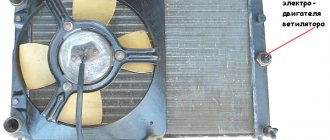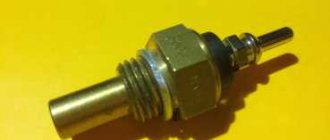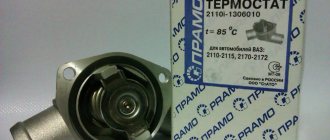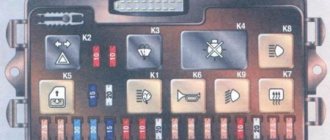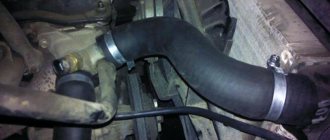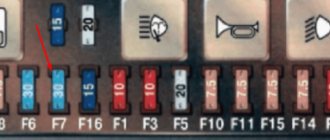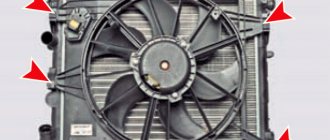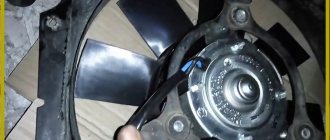The fan sensor on the VAZ 2114 is needed for cooling. The fan sensor for different models has different response limits. The fan switch on for the VAZ 2114 (8 valve engine) switches on at 102-105 degrees.
The fan control module has a microprocessor with software and a microchip with contacts built into one housing. A special coating is used to protect contacts and power lines from contamination and moisture. The control module receives signals, determines the best time to activate the fan and sends the corresponding electrical signal to the relay contacts (located in the heater shaft). When current flows to the relay winding, the core moves and the open contacts short-circuit, and this drives the fan motor.
Typically thermal resistors are used as coolant or engine section temperature sensors; These are semiconductor devices that change resistance depending on temperature. As a rule, temperature sensors have a threaded connection and are installed in the nozzle of the cylinder block cover. Modern cars often have several of these sensors. There are sensors with a built-in microprocessor, which is responsible for turning on a warning lamp if the temperature of the liquid reaches a critical level.
A little theory
Characteristic
Explanation
The sensor is located in the heater radiator. It is not difficult to determine that this is the one in front of you, since in the radiator it is the only element to which the wires are connected. And if you take a 30 key, then only the sensor has the appropriate fastener size.
Sensors may have different temperature limits. But for the VAZ 2114, switching on occurs at 102-105 degrees Celsius, and switching off occurs at 85-87 degrees. When choosing a new meter, focus on the one that has failed, or purchase one with an on and off indicator of 102 and 87 degrees, respectively
There is a special contact group inside the sensor. When the coolant in the radiator heats up, this group heats up and expands. When the expansion reaches a certain limit, the contacts close, they transmit a signal to the wiring and the fan turns on
The design of the cooling system and the principle of turning on the fan
Engine temperature indicator
Before we begin to directly consider the temperature at which the cooling fan turns on, it is worth understanding the operating principle itself. So, coolant circulates through the system and removes heat from the engine to the radiator. This element, in turn, conducts natural cooling of the liquid with a counter flow of air.
If natural cooling is not enough, the fan turns on. This happens under certain conditions.
Before considering all the factors and the temperature at which the fan turns on, it is worth understanding the design of the cooling system and the circulation of coolant:
1 – element in the form of a plug for the expansion tank; 2 – expansion tank; 3 – hose for draining liquid from the pipe; 4 – hose passing between the radiator and the expansion tank; 5 – hose leading from the radiator; 6 – tank to the left of the radiator; 7 – aluminum tube; 8 – plug systems; 9 – tank to the right of the radiator; 10 – drain plug; 11 – middle of the radiator; 12 – casing for electric fan; 13 – plastic wings of the electric fan; 14 – electric motor; 15 – toothed pump pulley; 16 – pump impeller; 17 – camshaft drive belt; 18 – engine block; 19 – pump pipe; 20 – radiator hose with supply function; 21 – heater radiator hose with drain function; 22 – hose supplying coolant to the throttle pipe; 23 – exhaust pipe; 24 – hose for refilling; 25 – heater radiator hose with supply function; 26 – thermostat; 27 – coolant temperature sensor; 28 – coolant level indicator sensor.
Reasons for fan failure
There are a number of reasons why the fan sensor can eventually fail other than the sensor itself. Therefore, they should first be excluded to make sure that the sensor is to blame.
Reasons for fan failure include:
- The fan has failed. It can wear out, lose integrity, and receive mechanical damage. It will be more expensive to replace it compared to the sensor, but there is no choice.
- The chain has broken. When testing a sensor, the method of closing two of its contacts is usually used. But if the wiring circuit is damaged, this will not be possible, and due to inexperience, all the blame will be placed on the regulator.
Sensor check
First, we advise you to check the sensor that you think is faulty. Even if it turns out that it doesn't really work, at least you'll have peace of mind.
Plus, be sure to check the new sensor before installing it. This will make sure it works. Today there are quite a lot of fakes on the market, so there is always a chance to purchase a low-quality fan sensor.
Searched object
To check you will need a certain set of tools and materials, which includes:
- Capacity;
- Water;
- Coolant;
- Thermometer;
- Multimeter.
Let's start checking.
- Pour water or regular coolant into the prepared container.
- Lower the sensor into it with the threaded part.
- Connect the multimeter terminal to the regulator contacts. The measuring device must be in resistance measurement mode. Although if the multimeter has a dialing function, then choose it.
- Place a thermometer into the liquid.
- Heat the water.
- When the liquid temperature reaches the regulator response temperature (92 degrees Celsius), the contacts should close and the multimeter will start beeping.
- If this does not happen, the sensor really does not work and needs a replacement.
If you purchased a regulator that is not working, be sure to go to the store and ask for a replacement or refund. But only if you have a receipt. It is better to purchase spare parts in specialized, good stores. There is less risk of getting caught by a fake.
Why the fan may not work
The signal from the control unit indicating engine overheating cannot be ignored. The faster you repair your cooling, the lower the risk of other breakdowns.
There are several main reasons why the fan stops working on a VAZ equipped with an injector. We are talking about:
- relay failure;
- broken wiring;
- fuse blown;
- poor contact in the pads;
- failure of the electric motor of the fan itself.
First of all, it is necessary to check the functionality of the blower. It's easy to do:
- disconnect the power connector from it;
- connect the terminal directly to the battery (the current is constant, but polarity is not necessary).
If the unit works, then the problem must be looked for in the electrical circuit, but when the problem is not resolved, it means that the electric motor is clearly faulty.
What to do if the electric fan runs constantly?
Sometimes another problem arises. Many car enthusiasts are interested in why the fan on the VAZ 2114 is constantly running?
There are four possible causes of the malfunction:
Most often, the fan starts to work continuously as a result of a shorted wire. The electrical circuit remains on regardless of the signals from the temperature sensor and relay.
To troubleshoot the problem, you need to ring each wire and find the fusion point. Sometimes it is noticeable even upon visual inspection.
If ringing does not help identify the malfunction, you need to check and replace the fan relay. The cost of the device is low. Therefore, for diagnostics it is easier to buy a new relay and install it in place of the old one.
If this does not help, then you need to check the operation of the temperature sensor. After all, it is he who is responsible for turning on and off the electric motor of the VAZ 2114 fan.
If all other elements of the system are working properly, you need to check the electronic module. It rarely fails. If the problem still occurs there, you will have to perform a complete error reset. Sometimes only a complete flashing helps. Not everyone can do this work on their own. Therefore, it is better to seek help from a car service center.
Causes of malfunctions
The fan may not turn on for the following reasons:
- the fan drive (electric motor) is faulty;
- fuse is blown;
- the relay has failed;
- broken electrical wiring;
- lack of contact in the temperature sensor connector;
- The temperature sensor is faulty.
Search for reasons
Diagnosis of a fan malfunction should begin with the fan itself. To do this, disconnect the connector on the fan and connect it, observing the polarity, directly to the battery terminals. If it turns on, it means the drive is working, the reason needs to be looked for further. If the fan does not work, this is the reason. But let's take things in order.
The fan did not turn on. We check the integrity of the wiring and the condition of the contacts on the sensor. If everything is in order, we move on to the fuse and fan relay. They are located under the hood on the left side closer to the driver, in the mounting block.
Fuse F4 is 20A, double, for the sound signal and the cooling fan (it is very easy to check; if there is no sound signal and the fan does not work, then most likely it is the culprit).
You can check the fuse with an ordinary autotester. With relays the situation is more complicated. To make sure that this is not the case, it is better to get a one hundred percent working relay somewhere and temporarily install it in the socket for testing. If the fan does not work even with it, we go to the sensor.
If the sensor is de-energized, the controller must start the fan in emergency mode for constant blowing. Disconnect the connector from it and turn on the ignition. Turning on the fan will indicate that the sensor has failed and requires replacement.
When is it necessary to change a fan?
If the cause is still in the fan itself, you can try to repair it. The problem is usually the brushes or bearings. But it also happens that the electric motor fails due to a short circuit or break in the windings. In such cases, it is better not to experiment and replace the entire drive.
It is strictly forbidden to operate a vehicle with a non-working cooling fan. Overheating of the coolant will inevitably lead to the destruction of rubber pipes and hoses, as well as cylinder head gaskets and valve covers. In addition, high engine temperature can cause destruction of the piston group elements.
How much does a cooling fan cost on a VAZ 2114
You can buy a new cooling fan for a VAZ 2114 for 1500-2500 rubles. Replacing this part at a service station will cost 300-400 rubles. But you don’t have to spend money on this. Dismantling the old fan and installing a new one at home will take no more than 30 minutes.
Why does the cooling fan turn on when the engine is cold?
The operation of a car's power unit is impossible without a cooling system. If problems arise with it, the motor may overheat, which will lead to its breakdown and costly repairs. One of the main elements in this system is the cooling fan. If any signs indicating a malfunction of this device occur, the cause should be found and eliminated. Since there can be many of them, it is worthwhile to dwell on each of them in more detail.
Lack of fluid in the system
The search for a problem should start directly with the coolant, or, more precisely, by checking its level. If it is below normal, the coolant sensor will operate even on a cold engine, thereby turning on the fan. This is explained by the fact that a small amount of liquid heats up much faster. To fix the problem, you need to check the antifreeze level in the expansion tank and radiator, and, if necessary, bring it up to normal.
The coolant level must be regularly monitored and replenished as necessary, since antifreeze can evaporate, which is especially typical in the summer.
Sensor short circuit
If checking the coolant does not produce results, attention should be paid to the sensor itself. There are times when this element “sticks”, which leads to constant rotation of the electric fan. For diagnostics, you will need a multimeter, which measures the resistance at the sensor terminals with the engine running. If the sensor is working, then the device should show infinite resistance. When the multimeter displays some resistance, it means that the contacts of the sensor are closed and it needs to be replaced with a working one.
Video: checking the fan switch sensor
Short to ground
Spontaneous turning on of the fan may be caused by problems with the fan itself. The problem is that its contacts are shorted to ground. As a result, the device operates directly from the battery, bypassing the circuit with the sensor. To eliminate the malfunction, you need to check the reliability of the fan connections, insulate the wires if necessary, and tighten the fastening. A constantly running fan can lead to the following consequences:
Thermostat sensor
Some modern cars are equipped with a thermostat with a sensor. This design solution allows you to control the cooling system with greater efficiency. However, if there is a problem with the sensor, the fan will run constantly. This behavior is explained by the fact that the signal from the thermostat is not received by the control unit. As a result, the unit goes into emergency mode. Checking the thermostat sensor is similar to the procedure with the coolant sensor.
Additional sensor
Some cars are also equipped with an air temperature sensor. Its main purpose is to regulate the temperature of oncoming air flows. When the ambient temperature is too high, the sensor sends a signal to turn on the fan. This way the motor cools better. If such an element is installed on your car, then during hot periods the fan will work almost constantly, helping to cool the engine. In this case, it is not recommended to disconnect the sensor, since the likelihood of overheating of the power unit increases.
Oxidation or broken contacts
If the car is equipped with a fan that is controlled via an electronic unit, there may be problems with the contacts themselves. Over time, they can oxidize, for example, when exposed to moisture, which is accompanied by constant rotation of the fan.
Every spring and autumn, it is recommended to clean the contacts from possible oxidation, and then coat them with a special lubricant.
Air conditioning system
There are cars in the design of which the air conditioning and cooling system of the power unit are interconnected. Therefore, as a result of a clogged air conditioning system radiator, the main radiator fan is activated. In this case, the air conditioner radiator needs to be flushed, and it is better to subject the devices of both systems to this procedure.
Connection diagram
Knowing the electrical diagram for turning on the radiator fan, it will be easier to find problems in its electrical circuit.
The cooling fan has 2 inputs: the first input leads to the generator through fuse F5 and the connection busbars in the mounting block (2). The harness block (3), nicknamed the chip by drivers, connects the electric fan via a relay to the injection controller connected to the ignition relay. From the wire coming from the controller, a branch leads to an auxiliary relay with a fuse.
Where is the fan relay located?
It is located in an additional block.
4 – electric fan relay;
5 – electric fuel pump;
Relays and fuses may have a different order. Therefore, you need to focus on the color of the wires. The main relay is always located at the bottom. Find the relay that has a thin pink wire with a black stripe coming from it. It comes from the main relay through pin 85. Be careful! Do not confuse this with the red thin wire, which also has a black stripe and extends from the controller. And find a thick white wire with a black stripe (pin 87). This is where the cooling fan relay is located. There is always a fuse next to it. It is an element of the chain.
Checking the functionality of the cooling fan motor
The easiest way to check the operation of the fan is to put two straight wires on it: minus and plus.
The plus is taken from the battery, the minus from the car body. If it doesn’t work when the circuit is closed, then that’s where the problem lies. When starting the blades, we look for the problem elsewhere.
Cooling fan operation diagram
Basically, when a non-working fan is detected, several reasons are identified:
- The electric motor is burnt out, there is a break in the winding;
- Wear of carbon brushes;
- The bearing has jammed or fallen apart.
If in the last two cases the problem is solved with little effort, so to speak, the first involves replacing the electric motor.
Important! When installing wires, the main power supply to the electric motor must be disconnected.
Installing a new sensor without draining the coolant
In the injection engine of most car models, the sensor is located high in the cooling system, which allows it to be removed without a significant spill of antifreeze. To do this, you must follow the instructions below:
- Do not unscrew the sensor completely. In this case, a slight leakage of antifreeze will begin;
- Check the copper washer on the new sensor;
- Unscrew the old device with one hand and quickly bring the new one in with the other;
- After tightening the regulator, thoroughly wipe the area from any coolant drips;
- Check the quality of installation for leaks.
With this method, the car owner can significantly save time. The disadvantage of this method is the need to make a replacement quickly, which can cause difficulties for inexperienced car enthusiasts. If the circumstances are unfortunate, a large amount of antifreeze may spill from the cooling system.
Keeping all elements of the cooling system in working order will protect the engine from overheating and unpleasant consequences. It is necessary to carry out timely monitoring of the operation of the regulator, especially when the first symptoms of overheating appear. Since the work requires the presence of heated fluid, all manipulations should be performed on a cooled engine. This will protect the car owner from thermal injuries.
The fan runs on a cold motor: causes, diagnosis, repair
Let's start with the fact that this problem can clearly indicate both a malfunction of the liquid cooling system and a malfunction of the fan itself. In any case, we are talking about a breakdown that cannot be ignored, since the risk of overheating of the internal combustion engine significantly increases.
For a better understanding, it is necessary to superficially consider the principle of operation of the fan on most modern cars. The airflow is activated by a special sensor located at the bottom of the radiator. Also, many cars use a separate engine cooling fan control unit. There are also models in which the ECU itself is responsible for turning on the fan, but this design is rarely used.
As you can see, the fan should not work on a cold engine. So, to determine why the fan turns on early, for injection cars with an OBD II diagnostic connector, it is recommended to start with computer diagnostics of the car. The fact is that the ability to read error codes from the ECU allows you to more accurately determine the cause of the malfunction.
We also note that in cases where the control unit detects errors in the cooling system, the fan can spin immediately after turning on the ignition, even on a cold internal combustion engine. This feature is found only on some models and is, in fact, protection against overheating of the power unit, since a constantly running fan reduces the temperature.
After repair, in this case you will also need to reset the errors. To erase an error from the ECU, on some models it is enough to remove the terminal from the battery for a couple of minutes, while on others the reset is carried out using diagnostic equipment.
Common cooling fan problems
Now let's look at common problems that are associated with the cooling system and the fan itself.
During the diagnostic process, the resistance at the outputs is measured on a cold sensor using a multimeter. Deviations from the norm will indicate the need to replace the element.
As a rule, leaks or decreased coolant levels in the expansion tank are the main cause. Please note that antifreeze is a mixture of concentrate and water. Water gradually evaporates from the system, causing the level to drop. For this reason, it is recommended to periodically check and add fluid according to special marks.
In this case, the fan can short-circuit to the battery and run non-stop. In such a situation, you need to check all contacts, wiring and other elements. Wires must be securely insulated and properly connected.
This solution allows for flexible control of the engine cooling system. However, if there is a problem with the temperature sensor in the thermostat housing, the fan may start running without turning off. The fact is that the control unit begins to receive incorrect signals about how the thermostat works. As a result, the emergency mode is activated, the fan turns on and runs constantly.
In such a situation, you need to check the sensor with a multimeter. Normally, on a cold engine its resistance is infinite, in other cases the indicator should be 100 - 500 Ohms. Deviations in the readings from the norm will indicate that the sensor needs to be replaced with a new one or a known good one.
This solution allows for more efficient cooling of the power unit, especially on cars that have a powerful forced-internal combustion engine and several radiators. On such units, the fan can be turned on in the warm season even on a cold internal combustion engine to protect against engine overheating.
To solve the problem, external cleaning of the air conditioner radiator and cooling system radiator may be required. The fact is that these radiators are located next to each other, dirt, dust and fluff accumulate between them. Removing such a “coat” allows you to normalize the operation of the air conditioning and engine cooling system, get rid of frequent fan starts and increased noise during its operation.
In order to avoid such a situation, experienced drivers recommend cleaning contacts before the onset of winter and summer for preventive purposes. Treatment with special lubricants and protective compounds is also actively practiced.
For what reasons does the VAZ-2114 cooling fan not work?
The VAZ-2114, like any other car, is equipped with an injector that works to cool the radiator. The fluid cools faster and the motor maintains its desired temperature. If the car is driving fast, then the fan will not work; the car has enough natural air flow. The cooling system starts to work when driving slowly or at a stop (if the engine is not turned off). But if the fan breaks, how to find and fix the problem. Read more about this.
How the cooling system works on a VAZ 2114
The cooling system is a pipeline through which a special liquid circulates. This fluid removes warm air from the engine to the radiator, where cool air lowers the temperature.
The cooling fan turns on on a cold engine: the main reasons and solution to the problem
As you know, various malfunctions of the engine cooling system do not allow the engine to reach the optimal temperature regime. The engine may overheat, which can lead to rapid breakdown, or remain cold, that is, not reach operating temperature.
Modern cars use a combined internal combustion engine cooling system: liquid and air cooling. By liquid we mean the circulation of antifreeze or antifreeze through special channels in the cylinder block and cylinder head of the engine.
The coolant circulates thanks to a pump. For additional cooling, the coolant can also circulate in a small circle (inside the engine) and in a large circle, that is, through the radiator.
Connection diagram for the fan switching sensor in injection engines
Unlike carburetor cars, where the sensor directly closes and opens the cooling fan circuit, in injection engines the device operates only with an information signal. After processing the received data, the ECU sends a control action to the fan relay installed on the radiator. The main advantage of this scheme is the possibility of emergency operation of the cooling system in the event of a loss of communication with the sensor or its failure. The ECU can also adjust the engine operating mode by influencing the injectors.
To determine where the fan switch sensor is located, you need to pay attention to the thermostat. In injection engines they are located next to each other. In some car models, wires go from the sensor to the dashboard to indicate the status of the device or to display the current coolant temperature.
The design of the cooling system and the principle of turning on the fan
Engine temperature indicator
Before we begin to directly consider the temperature at which the cooling fan turns on, it is worth understanding the operating principle itself. So, coolant circulates through the system and removes heat from the engine to the radiator. This element, in turn, conducts natural cooling of the liquid with a counter flow of air.
If natural cooling is not enough, the fan turns on. This happens under certain conditions.
Before considering all the factors and the temperature at which the fan turns on, it is worth understanding the design of the cooling system and the circulation of coolant:
1 – element in the form of a plug for the expansion tank; 2 – expansion tank; 3 – hose for draining liquid from the pipe; 4 – hose passing between the radiator and the expansion tank; 5 – hose leading from the radiator; 6 – tank to the left of the radiator; 7 – aluminum tube; 8 – plug systems; 9 – tank to the right of the radiator; 10 – drain plug; 11 – middle of the radiator; 12 – casing for electric fan; 13 – plastic wings of the electric fan; 14 – electric motor; 15 – toothed pump pulley; 16 – pump impeller; 17 – camshaft drive belt; 18 – engine block; 19 – pump pipe; 20 – radiator hose with supply function; 21 – heater radiator hose with drain function; 22 – hose supplying coolant to the throttle pipe; 23 – exhaust pipe; 24 – hose for refilling; 25 – heater radiator hose with supply function; 26 – thermostat; 27 – coolant temperature sensor; 28 – coolant level indicator sensor.
What should the engine temperature be?
According to the international automobile convention of December 1, 1992, where 92 representatives of the auto industry gathered, it was decided to establish a single standard for engine operating temperature.
This indicator is 90 degrees Celsius with a maximum permissible deviation of no more than 3 degrees Celsius.
Cooling fan connection diagram
But, given the region of operation and the ambient temperature, this temperature tends to rise. It is for this purpose that automakers came up with a cooling system fan, which provides additional cooling of the fluid in the system. It is driven by a temperature sensor, which detects it in the engine and is located directly on the power unit.
When the fan on the VAZ-2114 turns on
According to the decision of the convention and internal regulatory documents of the AvtoVAZ plant, the limit values for the coolant temperature are 85-105 degrees.
Thus, for normal engine operation, the system temperature should not rise above 105 degrees. This indicator is the starting point for turning on the cooling system fan. This data is stored in an electronic control unit, which regulates the operation of the fan.
The fan switching circuit looks something like this: the engine temperature reaches 105 degrees Celsius, then the sensor sends a signal to the ECU, which turns on the fan and stops it when the temperature in the system reaches 93-99 degrees Celsius.
Cooling temperature sensor
In summer and winter, as practice shows, the fan turns on at different temperatures and for different periods. In summer, forced cooling will turn on more often as the radiator is cooled by the hot air flow. In winter, the fan almost does not turn on or its operation is limited to a short period, since natural cooling is quite sufficient. Therefore, the main radiator breakdowns occur in the warm season.
The only nuance when cooling will often turn on in winter is if the thermostat is faulty (see “replacing the thermostat on a VAZ-2114”).
Replacement
- socket wrench 10;
- socket wrench 8;
- screwdriver with a Phillips bit.
- We park the car on a flat surface and immobilize it with the parking brake.
- Open the hood and disconnect the negative terminal.
- Using a 10mm wrench, unscrew the fastenings of the air filter housing.
- Using a screwdriver, loosen the air duct clamp on the air flow sensor and remove the corrugation.
- We unscrew the screws securing the cover of the air filter housing and remove the filter element.
- Using a size 8 wrench, unscrew the air intake mount and remove it.
- Using a 10mm wrench, then an 8mm wrench, unscrew the nuts securing the fan casing around the perimeter (6 pieces in total).
- Disconnect the wire block on the fan connector.
- Carefully remove the fan casing along with the drive.
- Using a 10mm wrench, unscrew the 3 bolts holding the electric motor to the casing.
- We put a new one in its place.
- We install the structure in place, fix it, and connect the connector.
- We carry out further installation in the reverse order.
Source
